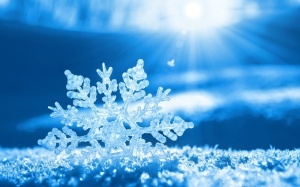 Living in Eagle County, we can all consider ourselves familiar with snow. We either fight it or love it all winter, but how often do we stop to appreciate its intricate and delicate nature? Snow, specifically individual crystals, are unique, but also undergo constant change, or metamorphosis, as they fall from the sky and turn into grains in our snowpack. By understanding that snow is constantly changing, we can learn a lot about our Colorado snowpack.
Living in Eagle County, we can all consider ourselves familiar with snow. We either fight it or love it all winter, but how often do we stop to appreciate its intricate and delicate nature? Snow, specifically individual crystals, are unique, but also undergo constant change, or metamorphosis, as they fall from the sky and turn into grains in our snowpack. By understanding that snow is constantly changing, we can learn a lot about our Colorado snowpack.
Snow starts in our atmosphere as water vapor that crystalizes on a nucleating particle (dust, smoke, and even bacteria) as the temperatures drop below freezing, 32° F. Depending on the amount of moisture and the temperatures in the environment, each snow crystal forms differently. But we most often associate snow with beautiful stellar dendrites. Stellar refers to the star-like shape and dendrites refer to the branch-like arms which create our familiar six armed flakes. The environment in which snow crystals are formed can vary widely though, and changes in temperature and humidity can dramatically affect the resulting crystal. If you look closely at freshly fallen snow in different conditions, you may also find plates, columns, needles, irregular crystals, graupel, ice pellets, or hail, and all in a variety of sizes.
If you dig into the existing snowpack on the ground though, you will again find dramatically different conditions for our snow grains. Once a snow crystal falls from the atmosphere and settles into the snowpack around our feet, they are referred to as grains. This is because the environment within the snow sets the stage for a unique metamorphosis, or change, of the crystals.
We often associate snow with cold temperatures, but we can also think of it as a great insulator for the ground and any animals that may live here year round, such as chipmunks, voles, mice, and ermine. Snow grains settle together in a way which keeps pockets of air trapped in the snowpack, much like our feather down jackets trap air around our bodies. This keeps our body heat trapped next to our skin. Similarly, this envelope of air between snow grains insulates the bottom of the snowpack, the ground, from the air temperatures above. This means that for most of the winter, the ground temperature stays around 32° F. Although freezing, this is warm enough to help some of these Colorado critters tolerate the winter environment and survive until spring. It also creates a special environment that allows these small creatures to tunnel and burrow through the snow, traveling out of sight from predators and out of the cold air temperatures. These changes within the snowpack are important to many of our furry friends, but they can also impact human travel on snow.
Continue reading part two HERE to find out more about how the insulating properties of snow facilitate changes within our snowpack that can have huge implications for humans traveling in the backcountry.
Rose is the Youth Programs Coordinator at Walking Mountains. Come by our Center in Avon (closed Sundays) or the Nature Discovery Center Yurt on top of the Lionshead Gondola on Vail Mountain (open daily) from 2:00-3:00 for a FREE Snowshoe Hike to learn more! View our snowshoe hike schedule.









